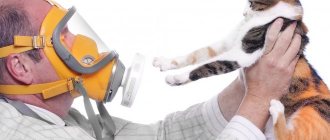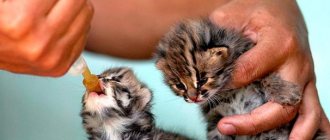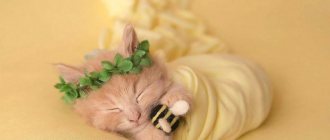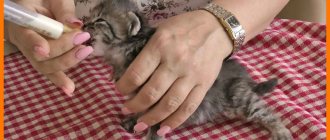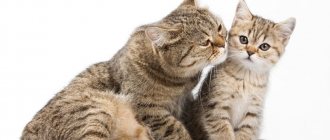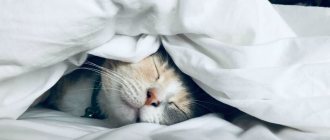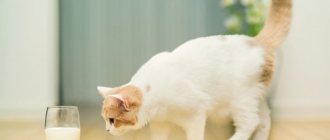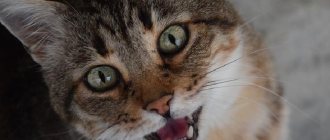Features of nutrition of a newborn kitten
For the first few weeks after birth, the baby feeds on the mother cat's milk. It contains all the nutritional elements necessary for a fragile body:
- microelements;
- antibodies that form colostral immunity, which contributes to the body’s immunity to various pathogens during breastfeeding.
The newborn baby is still weak and needs care
In the first days, the baby eats colostrum, which affects the immune system. Then it is replaced by milk. It contains antibodies that produce local immunity.
For your information! Cat milk promotes normal growth of the kitten. This feeding is the best option for a newborn pet.
Breastfeeding by a mother cat is carried out for 40-60 days from the moment the babies are born. Based on the size of the kittens, they can be breastfed for up to 6 months. But only for the first 1.5-2 months the cat provides basic nutrition.
Mom is able to feed several kittens at once
Feeding mode
For normal growth and development of a kitten, it is extremely important to adhere to the feeding regime and correctly calculate the amount of food needed to compensate for basic physiological needs. To be sure that you do not overfeed the kitten, the serving size must be calculated using the following algorithm:
- Calculate the daily feed intake based on caloric content and protein content.
- Divide the daily feed amount by the number of feedings.
At the age of 6 months, kittens become active at certain times of the day. After a period of activity, the kitten should receive a full portion of food; if the baby just woke up or got hungry while resting, a snack will be enough. In total, during the day, the kitten should eat 4-5 times and have a snack 1-2 times.
Features of nutrition during the transition period
It is worth knowing when kittens need to be taught to eat. The first complementary foods are introduced at 4 weeks. As the basis of the diet, it is recommended to give the baby baby food - curds “Agusha”, “Tema”.
How to introduce first complementary foods
When kittens open their eyes: how many days after birth
Then you need to introduce meat jars, starting with chicken, beef. From the 5th week, finely chopped chicken fillet is offered. First, the whole piece is placed in the freezer, then thawed at room temperature and covered with a little calcide. It can be found in any pharmacy, it consists of eggshells. The drug is well absorbed by the body. One tablet is crushed into powder and sprinkled with 100 g of meat.
The kitten is also offered special professional food for babies from 1 month. has proven itself well in this regard. It produces a light mousse designed for kittens.
Drinking regime
The daily dose in drinking is calculated as follows: the weight of the animal is multiplied by 0.03. The indicator will show the required amount of liquid that the pet should drink per day. The value also includes the water present in the wet food. Usually it takes 80%.
It is best to give your baby clean, filtered water. If it is hard, smells of bleach, and rotten, then he will refuse it.
Note! Cats like the bowl to be full and wide, and their whiskers should not touch the container.
Some cats love to drink from a fountain.
Water in a kitten's diet
Water plays a fundamental role in metabolism and the process of hematopoiesis. Thick blood makes it difficult for all organs to function and slows down metabolism. If the water-salt balance is disturbed, and this is possible if the kitten does not receive enough water, the pet grows or develops untimely.
To avoid health problems, make sure your kitten has easy access to water. If necessary, place several additional drinking bowls in your home, but do not forget to regularly change the water in them. The water must be fresh, because if it sits in a bowl for 10–12 hours, bacteria will begin to multiply in it, and this is one of the causes of indigestion and problems in the gastrointestinal tract.
How to determine if a kitten is ready
When do kittens change teeth: symptoms and at what age
From 4 weeks after feeding the kitten, the cat’s milk supply begins to decrease. She tries to avoid kids and takes long walks. Kittens begin to instinctively look for additional sources of food. By this time, they move well, orient themselves in space, and their baby teeth are erupting.
The cat brings the kittens to the kitchen, showing them the place where they should eat. If you don’t start feeding your pets, they will lag behind in development and growth, and lose weight.
What to feed a 6 month old kitten
If you become the owner of a six-month-old kitten, it is advisable to find out what he was fed before moving into your home. If such information is not available, for example, you bought a kitten at a poultry market or picked it up on the street, you need to create a diet based on the urgent needs at the moment.
When deciding what to feed your kitten, you need to choose between three basic options:
- Natural feeding.
- Industrial feeding.
- Mixed feeding
Mixed feeding is not recommended by veterinarians and prepared food manufacturers, although it is practiced by thousands of owners. Mixed feeding involves preparing a diet from ready-made feed and natural products.
Typically, the cat receives ready-made food for breakfast and food prepared from natural products for dinner.
A mixed type of feeding is a direct path to dysbiosis, and this, in turn, is the first reason for inadequate absorption of food.
Natural products
A natural diet is considered more natural for a cat, however, when preparing it, it is necessary to take into account the peculiarities of physiology. When developing a menu, you need to rely on one of three methods of natural feeding:
- Raw and cooked foods, pure and mixed.
- Exclusively raw products.
- Semi-finished products from natural homemade products.
When can kittens eat themselves?
Why does a cat bite its owner’s legs: when you stroke it and for no reason
Self-feeding begins at one month. At this time, the cat or owner must teach the baby to feed.
Diet of a kitten aged 1-1.5 months
Animals aged 1 to 1.5 months must be fed liquid food 5-6 times a day. What to enter in the menu:
- vegetable or meat puree;
- liquid semolina porridge without sugar;
- skim cheese;
- boiled yolk.
It is important that dairy products do not contain any additives
Complementary feeding at 2 months of age
From the age of 2 months, the kitten's baby teeth erupt, so solid food is introduced. But liquid dishes cannot be removed, since they form the proper functioning of the digestive system.
At this age, the pet is fed:
- boiled lean meat;
- yolk;
- milk;
- cottage cheese;
- yogurt.
Important! Gradually the kitten grows, the need for food and nutrients increases. From an early age, you need to accustom your baby to fish, cereals and vegetables.
Nutrition for a 3 month old kitten
At this age, pets are actively growing, they are full of strength. Their teeth change, their skeleton intensively strengthens and develops, and their muscles grow. The total weight of food eaten per day should be about 200 g per 1 kg of weight. With normal size kittens, 400 g of food per day will be enough.
A baby at the age of 3 months needs to be fed 5-6 times a day. When he turns 4 months old, you can switch to 4 feedings a day. When choosing any diet, you cannot deviate from it.
Important! It is prohibited to combine the consumption of store-bought feed and homemade food.
The pet needs to be fed solid food rich in protein. Dairy nutrition needs to be varied. Experts recommend preparing vegetable dishes. Meat products should predominate; cereals make up less than half of the daily feeding.
Meat is necessary for the growing body because of its taurine content. The substance is important for the normal development of the eyes and heart. Natural nutrition does not mean that your pet needs to be fed from your table.
When kittens begin to eat themselves, it is recommended to include in the menu:
- boiled lean meat - chicken, beef, turkey;
- if there are no worms, you can give raw frozen meat, chopped into small pieces;
- fermented milk products without additives - yogurt, kefir;
- liquid cottage cheese;
- zucchini, pumpkin, cabbage in raw grated form. If the baby refuses, then you need to add the mixture to the porridge;
- boiled egg yolk;
- sea fish;
- porridge with milk. It is better to cook semolina and rice.
The kitten is also offered special greens grown on the windowsill, sprouted oat sprouts
What is the duration of natural feeding of newborn kittens with mother's milk?
In nature, in their natural habitat, a mother cat feeds her cubs for quite a long time. In a small litter (up to 5 kittens), breastfeeding can last up to six months. But the main period lasts about 3 months:
- At 1.5 months, kittens gradually become accustomed to solid food, but breast milk remains the main food.
Breastfeeding can last up to six months, but only for the first 2 months mother’s milk is the main nutrition for the baby
- By 2–2.5 months, the number of feedings decreases, and the mother increasingly offers the children solid food - prey brought by her.
In street conditions there is no talk of any special diet. But for pets the translation process is different, and it is possible to choose food for babies that best meets the needs of a growing kitten.
What to do if a kitten finds itself without a mother
A kitten may be left without a cat for various reasons. A person’s task is to replace his mother as much as possible, to provide food, security and education.
First of all, you need to equip a place for the baby. It should be quite secluded. This could be a special house for cats or a box - there are many options. It is necessary to line the bottom with soft flooring: put a blanket or diaper. The place for the house should not be located in a draft, but it should not be installed near a battery either.
Heat exchange in kittens is not yet perfect, so for very small ones (up to 2 weeks), additional heating should be provided, for example, placing hot water bottles wrapped in a towel in a box.
The owner will also have to feed the baby. Newborns are fed quite often - every 2-3 hours. In veterinary pharmacies you can purchase special bottles with nipples, as well as dry formula - a cat's milk substitute. True, the latter is quite expensive, so you can prepare nutritious milk yourself. Whole cow's milk is not suitable for feeding kittens; it does not have sufficient nutritional value and can cause digestive disorders.
There are dry formulas from different manufacturers on sale for feeding kittens.
Video: how to prepare a mixture for a kitten yourself
When is the kitten ready for feeding?
Despite the fact that breastfeeding can last for quite a long time, you can start teaching a kitten to feed itself from 3 weeks of age. This applies to all babies and does not depend on belonging to a particular breed. As soon as the kittens begin to more or less stand on their feet and walk, you can try offering them other food.
My cat had 3 kittens in her litter. They started walking at the same time, but eating from a bowl at different times. One of the babies, already a month old, deftly handled thin porridge and even tried to steal a dry food pellet from his mother’s plate. The second one mastered lapping from a bowl by 1.5 months. But the third one ran away from the plate like fire for up to 2 months, and then ate very little. He preferred to find his mother and latch on to the breast. So it seems to me that readiness for complementary feeding is an individual trait.
How to accustom a kitten to a bowl
When introducing a kitten to a bowl, you need to take into account the fact whether he lives with his mother or alone. If the pet is with its mother, then she will teach it everything necessary: to eat, to escape, to repel the enemy, to clean its fur. When a cat teaches a baby to feed, she clearly shows him how to lower his face into the bowl and what movements should occur. She chews food and swallows it. The mother, with her purring and appearance, calls the kitten to the bowl.
The baby's brain absorbs all information like a sponge. He can repeat all the actions. But in life this doesn’t always happen; sometimes the owner is forced to teach the kitten everything. It is worth remembering that a resident can not only learn feeding skills from a person, but also habits such as going to the toilet and brushing their teeth. The owner must begin training by personal example.
You should learn how to teach a small kitten to eat from a bowl on its own. It is necessary to demonstrate to the baby how to eat on the floor from a plate. If he doesn’t copy the behavior, they take him on his lap and the plate too. A cozy environment is important for cats; they love warmth. The food is smeared onto the pacifier or finger and offered to the pet. This way he will quickly remember how he ate his mother’s milk. When your pet licks the food, it will develop an appetite. The food is placed in a container for him to see. If he behaves absent-mindedly, it means he is not hungry or wants to sleep, so training is stopped.
Note! When the owner goes to the kitchen, he must say “let’s go eat.” After several attempts, the kitten will begin to remember these words; they will be associated with feeding.
Another way to teach a kitten to eat on its own:
- Lay a towel on the floor and place a bowl on it.
- The milk is heated to a temperature of 36 °C and poured in small portions into a container.
- The pet is placed near the plate and its nose is carefully dipped into the milk.
- If necessary, the process is repeated several times.
The third way to teach a kitten to eat on its own:
- Take a tablespoon of warm milk.
- They bring it to their mouth and let it taste.
- The spoon is held at the level of the muzzle, then the kitten will have no choice but to lick the milk.
Important! The sooner the process of introducing a kitten to a bowl and feeding itself begins, the faster it will master the necessary skills.
Until the baby is one month old, you cannot teach him to eat from a bowl. He is still weak and not strong enough. If a newborn kitten is left without a mother, then you need to offer him milk from a pipette, then a bottle with a nipple. A small pet should receive food often. As they get older, the number of feedings decreases.
Babies sometimes get into the bowl, no need to pull it back
Advice from experts on accustoming kittens to new food and bowls
Successful training in self-feeding largely depends on the dishes in which the kitten is offered food. It should be low, not slip on the floor, and the bowl must be clean. It is highly undesirable to wash it with the product. The fact is that kittens have a keen sense of smell, and foreign odors will only scare it away.
A lot in teaching a kitten to feed itself depends on the bowl in which the food is offered.
Experts also give the following recommendations for introducing complementary foods:
- New food should be introduced gradually, mixing it with the usual one.
- The consistency of the food should be thickened over time and only after the kitten laps from the bowl on its own.
- You need to carefully monitor the temperature of the food offered (it should be about 37 oC). Hot or cold food will scare the kitten away, and he may not return to the bowl any time soon.
- You should ensure a calm environment while the kitten is eating, excluding sudden sounds and movements of household members.
- If there are other pets in the house, it is advisable to exclude their access to the kitten while it is feeding.
Video: how to choose a bowl for a kitten
How to accustom a kitten to a change in diet
If the owner plans to feed the pet natural food, then it is worth thinking about the diversity of the diet. Introducing your pet to new foods and dishes is not difficult. Some recommendations:
- the introduction of new complementary foods should occur gradually;
- a small amount of the product is combined with the baby’s usual food;
- when the animal refuses to try, you need to apply a little on your finger and let him lick it off.
Important! You should be prepared for the fact that your pet will refuse new food. In this case, you need to try to offer something different.
Do the same when switching to dry food. Combining homemade food with store-bought mixtures is harmful and unsafe. But if the owner decides to change the diet, then for a certain period it is worth deviating from the rule.
To switch to dry formula, it is crushed and mixed with the baby’s main food. Every day the amount of feed is increased, gradually homemade food will be replaced. During this period, the kitten’s body needs more water.
Power change scheme
Why do you need to monitor a kitten’s weight at different periods of its growth?
Despite the large breed and individual characteristics of a kitten, changes in its weight at a certain age can be used to judge whether it is developing correctly. There is a breed standard that sets out weight standards. Deviation in either direction is not acceptable. Of course, a lot depends on the mother's milk supply. Therefore, it is recommended to feed her well.
The calorie requirement of a lactating cat is, on average, 3 times greater than for a pet at rest. Therefore, ad libitum feeding is practiced. To prevent food from spoiling, it is necessary to switch to professional nutrition with dry granules containing the necessary vitamins and other nutrients.
The industry does not produce special food for pregnant and lactating cats. Therefore, they use super premium food for kittens. This approach keeps milk production high and helps the kitten transition from mother's milk to solid food.
The weight of a younger kitten should constantly increase and double by the age of one week. Responsible felinologists weigh a newborn in the first week of life every day at the same hour. Then the frequency of mass determination is reduced and after six months monthly weighing is sufficient. Constant weight gain is considered an indicator of a pet's good health.
Be sure to read:
How to care for a British kitten: feeding, training, mating features, when to vaccinate
Kitten owners are concerned about moments when the growth rate drops or stops altogether.
In most cases, this is explained by the following objective reasons:
- Weaning : the transition from mother's milk to solid food requires a restructuring of enzymes.
- Deworming in preparation for vaccination. Dying parasites release toxic metabolic products, poisoning occurs, and growth stops.
- Post-vaccination complications: even if the kitten’s health worsens for a few days, there is no need to worry about it.
- Changing teeth: the pet is in a little pain, food eating decreases.
- Upon reaching six months of age, feed consumption decreases and growth rate decreases. But these are the physiological features of the development of cats.
- Puberty and the first estrus are accompanied by small plumbs.
In addition to physiological reasons for growth inhibition, pathological ones may appear: poisoning, infection or invasion.
Why may a kitten refuse food?
Most of the reasons why a baby does not want to eat are not associated with painful conditions. There may be several reasons for refusal.
- Stress. If a baby is torn away early from his mother cat or transported from a nursery, he will initially feel uncomfortable in his new home. Sometimes, when changing residence, the kitten completely stops eating and drinking, then for 2 days he never goes to the toilet. This is very dangerous because it causes dehydration and intoxication of a still fragile body. During periods of stress, you need to show care and attention towards the new resident, take him in your arms.
- New food. Previously, the kitten received nutrition from its mother, it ate milk. The loss of milk manifests itself as a shock to the kitten’s body.
- They removed him from the cat early. The kitten simply cannot learn to eat food because it was torn away from its mother early. In this case, he needs to be fed with an analogue of cat's milk, which is sold in pharmacies. If you can’t buy it, goat will do.
- Dirty dishes often become a factor in refusal to eat food not only for kittens, but also for adults. Also, the animal will not like plastic dishes with an unpleasant odor.
- Worms and parasites. This causes poor appetite or complete refusal to eat. The kitten loses weight, its fur deteriorates, diarrhea and vomiting occur. In this case, the help of a veterinarian is necessary.
Important! If, in addition to poor appetite, the baby exhibits additional symptoms such as lethargy, diarrhea, and bad breath, then you should immediately go to the clinic. You cannot risk the health of the animal.
Cat's milk is an essential food during a kitten's early life. When it reaches 3-4 weeks, you can introduce simple food into the diet - cottage cheese, milk, porridge. You should always watch your baby and his reaction to foods. Then the kitten will grow up healthy, beautiful and well-groomed.
Vitamins and supplements
When kept on high-quality, industrial feed, vitamins and additives are not required. It is important to understand that an excess of vitamins and microelements is no less dangerous than their deficiency. With a natural feeding method, vitamin supplements should be present in the diet on an ongoing basis at least until the age of one year.
A kitten can get basic vitamins and nutrients from natural products:
- Meat and bone meal.
- Fish, chicken, beef liver.
- Greens, vegetables, fruits.
- Sunflower oil, olive oil.
- Brewer's yeast.
